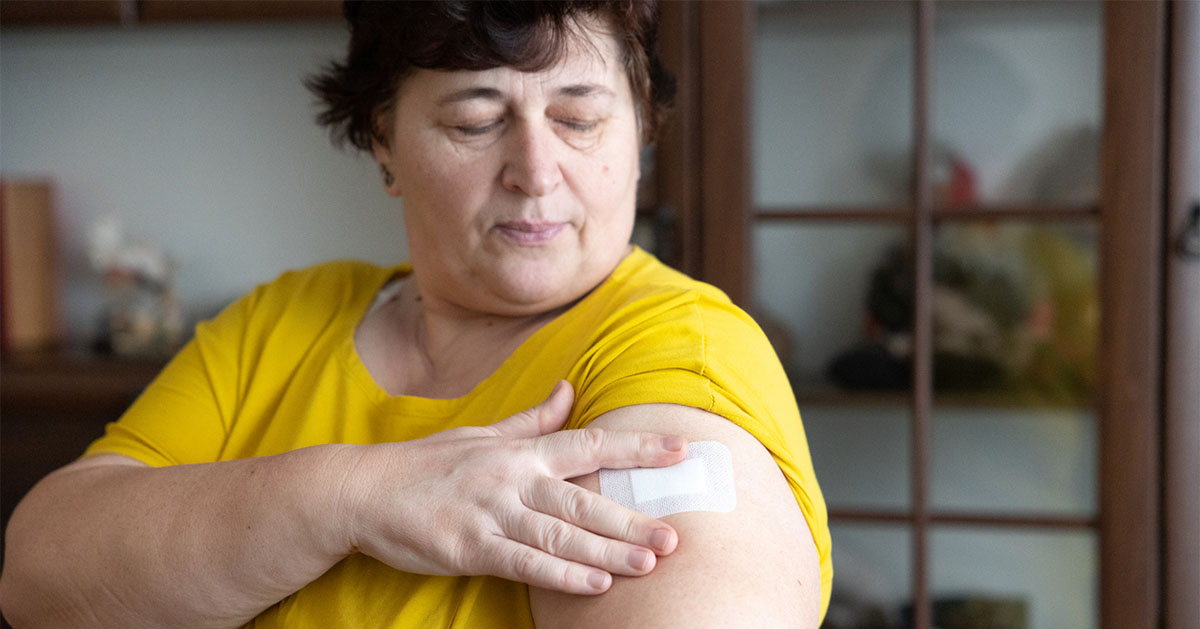Many years ago, at university, one of us (KG) was taught a very memorable acronym for assessment of peripheral arterial disease, “Please Can Teddy Talk Sense”, and he has used it every day in clinical practice since. Below we use this mnemonic to cover key aspects of foot assessment.
Please: Can you feel the pedal pulses?
There are two main arteries that supply the foot, the posterior tibial artery and the anterior tibial artery, with the latter continuing under the dorsal surface of the foot as the dorsalis pedis artery. If you are unable to feel a pedal pulse as strongly as you would expect when palpating a radial pulse, then we would recommend picking up a Doppler and having a listen. Pulse palpation is not wholly reliable, whereas an increasing stenosis results in progressive dampening of the waveform and development of a monophasic pattern (Vowden and Vowden, 2002). If a monophasic waveform is detected, then refer onwards for ankle–brachial pressure index assessment or arterial duplex.
Can: What colour are the feet?
Colour may give a good indication of the patients’ vascular supply. A very white or pale foot could indicate a poor perfusion. A red (erythematous) or “sunset” colour indicates vasodilation and could be a result of autonomic neuropathy (i.e. damage to the small nerves that invaginate the arteries, causing relaxation of the smooth muscle and thus the occurrence of a flush effect); however, it could also represent a reactive hyperaemia. When tissue hypoxia occurs, the body tries to combat this through vasodilation and again we see the “flushing effect”, but a reactive hyperaemia may indicate peripheral arterial disease (PAD) and therefore a red foot should prompt further investigation. A red foot could also indicate infection. Simply elevating the limb will determine if this is the case: with vasodilation it will turn white when elevated, as the blood drains, while with infection it will remain red.
A blue foot is normally attributed to a poor venous return and is usually not serious. However, if the cyanosis is non-blanching (i.e. it does not turn white when pinched), this could indicate pre-gangrenous changes or end-artery embolism and may warrant further investigation and urgent referral to a vascular surgeon.
Teddy: Is the temperature normal?
The normal temperature gradient of a limb should go from warm to cool: as the blood flows distally to the peripheries and away from the core it cools slightly. A cold foot could be normal but could represent poor perfusion. This should raise concern and be evaluated, taking into account the whole clinical picture. A warm foot is ideal, but if it is hot (i.e. greater than normal body temperature [>37°C]) or warm in patches, then infection or Charcot arthropathy should be considered.
Charcot arthropathy will only occur in people who have neuropathy (it is not a complication of diabetes per se). Charcot arthropathy is a devastating condition in which bony remodelling causes severe destruction and deformity. It is a clinical emergency. The foot will normally be very hot (2°C warmer than the contralateral foot), swollen and sometimes painful. If you are in any doubt, the individual should be referred to a multidisciplinary team within 1 working day. Offer non-weight-bearing treatment until definitive treatment can be started by the multidisciplinary foot care service (NICE, 2015).
Talk: Are there any noticeable trophic changes?
Is the skin dry, fragile, cracked, itchy or with callosities? If the skin is dry then a suitable emollient should be considered. Evidence suggests that once-daily applications of an emollient containing 25% urea on the soles of the feet by people with diabetes could significantly improve skin barrier function and integrity (Locke et al, 2012). When choosing an emollient, evidence for clinical and cost-effectiveness should be considered. Once Heel Balm (Dermatonics Ltd, St Ives) is clinically effective with once daily application; this increases patient compliance and thus has a positive effect on cost-effectiveness (Young et al, 2014). A pictorial scale enabling practitioners to record the dryness of foot skin and match a foot skin type with the most effective emollient has been developed by Young et al (2014).
If the skin is fragile it is important to ascertain why and to try to address the cause. Also check if there are any ulcerations; if so, the person should be referred immediately to an appropriate foot protection team (NICE, 2015). If the feet are dry, flaky or cracked and are itchy, consider a fungal infection and treat, if appropriate, with topical antifungals (e.g. clotrimazole 1% twice daily).
If there appears to be venous insufficiency (e.g. cyanosis, varicose veins, brown staining [haemosiderin] or oedema), then the individual should be referred to a specialist clinician, possibly for support stockings or compression hosiery.
Sense: What are the patients’ subjective symptoms?
Here we are trying to differentiate between a multitude of problems. The main four are summarised in Table 1.
Managing PAD
People with PAD have a very high mortality rate. Therefore, if PAD is identified, it is vital that the modifiable cardiovascular risk factors are addressed in order to reduce the risk of heart attack and stroke. NICE (2010; 2014) recommends that people diagnosed with PAD are commenced on a statin (e.g. atorvastatin 80 mg once daily) and an antiplatelet agent (e.g. (clopidogrel 75 mg once daily).
What is sensory neuropathy?
Simply put, sensory neuropathy is the impairment of feeling pain, temperature or pressure in the foot. It can be tested for, and the assessment should be carried out using a 10-g monofilament (NICE, 2015).
The International Working Group on the Diabetic Foot (Lipsky et al, 2015) suggests that there are three sites to be tested on each foot:
- The apex of the hallux.
- The first metatarsal head.
- The fifth metatarsal head.
It further notes the following:
- Where possible, the exam should be carried out in a relaxed and quiet setting.
- The patient should be asked to feel the sensation of the monofilament bowing on their hand and then asked to close their eyes for the test.
- The monofilament should be applied at 90° to the site and pressure applied to cause the filament to bow in the middle; it should then be removed.
- The three sites should be tested in order, a minimum of twice, with at least one site being purposefully omitted in the process and tested out of sequence in order to ensure that the patient is actually feeling the applications.
Sensation is deemed to be: absent if the person fails to report application of the filament twice at the same site; and present if they correctly report two applications at the same site. It may therefore be necessary to make a third or even fourth round of applications, as two correct answers or two incorrect answers are needed to make a diagnosis. Once diagnosed, it is important to help the person understand that they have lost the protective ability to feel pain and pressure, and onward referral for general foot care management is advised.
Author’s conclusion
Vascular risk assessment is complicated and the whole clinical picture needs to be considered. If the pulse is weak or you are uncertain, always insonate using a hand-held Doppler. Identification of peripheral arterial disease (PAD) should be followed up with appropriate onward referral, along with identification and management of an individual’s modifiable cardiovascular risk factors. Commencement of atorvastatin 80 mg once daily and clopidogrel 75 mg once daily in people with PAD can significantly improve their mortality risk, preventing heart attack and stroke. The identification of neuropathy is a simple yet effective test. If neuropathy is detected then appropriate healthcare information should be given alongside a referral to a local foot protection team.
Questions to test your knowledge
- What acronym can help with a thorough peripheral vascular assessment?
- What two medicines can reduce mortality risk if initiated in a person with peripheral arterial disease?
- How might a person with ischaemic rest pain relieve this?
- Which of the following is not a site recommended by the International Working Group on the Diabetic Foot for monofilament testing?
[a] Apex of the hallux
[b] First metatarsal head
[c] Third metatarsal head
[d] Fifth metatarsal head - Intermittent claudication lasts for longer than 10 minutes when the person stops walking and only occurs once.
True or false?
Answers
1 – Please Can Teddy Talk Sense
2 – atorvastatin 80 mg once daily and clopidogrel 75 mg once daily
3 – by dangling their legs out of bed
4 – [d]
5 – False (less than 10 minutes and is a repeatable cycle)





Increased risk of new-onset heart failure in over-65s suggests caution is required before prescribing pregabalin for painful diabetic neuropathy.
14 Aug 2025